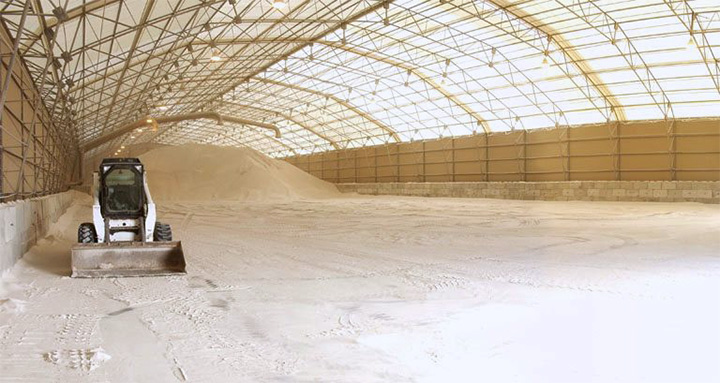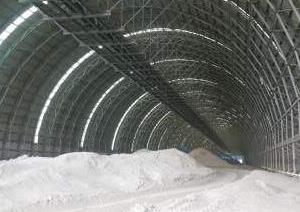Limestone Storage:
The most common raw materials used for cement production is limestone, which is usually extracted from a quarry adjacent to or nearby the cement plant. The selected limestone is then crushed, ground, and proportioned so that the resulting mixture has the desired fineness. Stocking of limestone covered in limestone storage sheds not only minimizes the problems (like caking, particle segregation etc) but also improves plant efficiency and maintains quality of limestone.
Clinker Storage:

Production of cement is considered to be a dry process with multi-stage suspension preheating and precalcination (where calcium oxide is burn with silica, alumina, ferrous compounds and others & produces another intermediate compound known as clinker). The clinker storage can be kept as open or closed (under clinker storage shed) type. The nodules of cement clinker are then grinded with other additives like gypsum, sulphur to produce powdered cement.
Loss Prevention And Damage Control Measures in cement production:
Cement is a basic construction material for building and civil engineering. The cement industry is an energy intensive industry & output from the cement industry is directly related to state of the construction business along with some factors related to loss prevention of resources like limestone, gypsum, clinker etc. Many cement plants have followed general primary measures, such as process control optimization, solid fuel feed systems, optimized cooler connections and use of optimized power management systems, but forgotten to imply the prevention and damage control measures, which exhibits very essential base for the implementation of a quailty cement production. The Loss Prevention And Damage Control measures are as follows:
- Prevention of Caking i.e. Full or partial solidification of resources.
- Elimination of Particle Segregation Problem.
- Removal of Moisture Problem.
- Prevention of Flow Blockage Problem.
- Suppress the Chemical Oxidation of Resource.
After considering prevention and damage control measures, the proportionate distribution of clinker, gypsum and fly ash is done by electronic weigh feeders. In modern cement plants, clinker and gypsum are precrushed in a roller press and subsequently fed into ball mill for fine grinding. The installation of roller press technology is very beneficial in terms of both quality and energy conservation. The cement produced from roller press is showing better particle size distribution in cement (and hence good strength development) and consumes less power. The resultant product is called cement.


